A popover pan, a staple in many baker’s kitchens, is a specialized baking vessel designed to create the perfect popovers—light, airy, and delectably crispy on the outside.
This pan’s distinct design features deep, narrow cups that encourage the popover batter to rise dramatically, resulting in the signature tall, hollow centers that popovers are known for.
As versatile as it is charming, the popover pan isn’t limited to popovers alone; it can also be used for creating muffins, cupcakes, and individual-sized desserts, making it a must-have for any baking enthusiast seeking to add a touch of elegance and whimsy to their culinary creations.
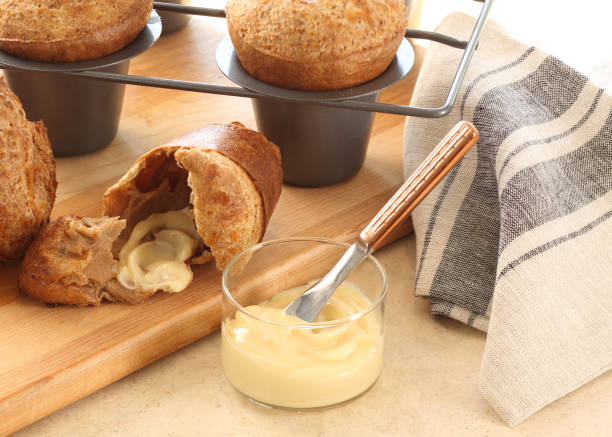
What Is A Popover Pan
A popover pan is a specialized baking pan designed specifically for making popovers, a type of light and airy pastry with a crisp crust and a hollow interior.
Popover pans are typically made of heavy-duty materials like cast iron or aluminum, featuring deep, narrow cups that help the batter rise and create the signature popover shape.
These pans are often non-stick or coated to ease the removal of popovers and ensure even baking. Popovers are a popular treat for breakfast or brunch, known for their versatility in flavorings like cheese, herbs, or sweet additions like jam or honey.
The popover pan’s unique design promotes optimal heat circulation, allowing the popovers to achieve maximum height and a golden-brown crust.
Whether enjoyed plain or filled with delectable fillings, popovers baked in a dedicated popover pan offer a delightful culinary experience, perfect for impressing guests or indulging in a homemade bakery delight.
History and Origins of Popover Pans
Origins of Popovers as a Baked Pastry
Popovers are a type of light, hollow roll made from an airy batter that puffs up during baking. They have a long history dating back to the 19th century.
The exact origin of popovers is somewhat debated, but they are believed to have originated in the United States, particularly in New England. One popular story traces their name to the fact that the batter “pops over” the sides of the baking cups, creating a light and fluffy texture.
Popovers gained popularity as a delightful addition to breakfast or brunch tables, often served with butter and jam. Their simplicity and versatility made them a favorite among home bakers and professional chefs alike.
Evolution of Popover Pans in Culinary History
The evolution of popover pans mirrors the development of baking techniques and materials over time. Early popover pans were typically made of cast iron, featuring deep cups that allowed the batter to rise and form the characteristic popover shape.
These pans were designed to conduct heat evenly, ensuring that the popovers baked uniformly and developed a crisp exterior while remaining tender inside.
As baking technology advanced, popover pans evolved to include non-stick coatings and materials such as aluminum and stainless steel. Modern popover pans often come in different sizes and shapes, allowing for variations in popover presentation and serving options.
Cultural Significance of Popovers and Popover Pans
Popovers and popover pans hold cultural significance in various culinary traditions. In the United States, they are associated with comfort food and traditional American cuisine, often served alongside classic dishes like roast beef or chicken.
Popovers also have a presence in British cuisine, where they are known as Yorkshire puddings and are a staple accompaniment to roast dinners.
The popover pan itself has become a symbol of baking heritage and innovation, representing the ingenuity of cooks and bakers throughout history. Its versatile design and enduring appeal have ensured its place in modern kitchens, where it continues to inspire creativity and delicious baked creations.
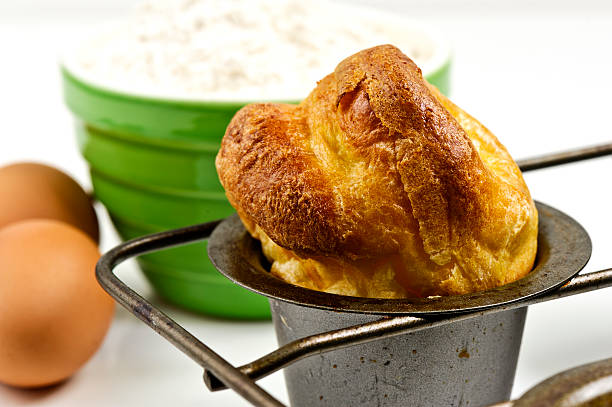
Components and Structure of Popover Pans
Description of the Shape and Size of Popover Pans
Popover pans typically have a distinctive shape characterized by deep, narrow cups that are taller than they are wide. The cups are designed to allow popovers to rise and expand during baking, creating the signature hollow center and puffy texture.
The size of popover pans can vary, with some models having six cups while others may have twelve or more, providing flexibility in batch sizes and serving portions.
Materials Commonly Used in Making Popover Pans
Popover pans are constructed from various materials, each offering unique benefits for baking. Traditional popover pans were often made of heavy-duty cast iron, known for its excellent heat retention and durability.
However, modern popover pans also come in materials such as aluminum, stainless steel, and non-stick coated metals.
Aluminum pans are lightweight and heat-responsive, while stainless steel pans are durable and resistant to corrosion. Non-stick coatings provide easy release of baked goods and simplify cleaning.
Variations in Design and Features of Modern Popover Pans
Modern popover pans exhibit a range of design variations and features to cater to different baking preferences and needs. Some popover pans have a reinforced rim for added strength and stability, ensuring even baking and preventing warping.
Others may feature extended handles or grips for easy handling, especially when hot. Non-stick popover pans are popular for their convenience, allowing popovers to release effortlessly from the cups without sticking.
Additionally, there are popover pans with interchangeable plates, allowing for versatility in baking different types of pastries or muffins in the same pan.
Common Uses of Popover Pans
Here are the common uses of popover pans:
Traditional Recipes That Utilize Popover Pans
Popover pans are primarily used for baking popovers, a classic pastry enjoyed for breakfast, brunch, or as a side dish. Popovers are often served with butter and jam, making them a delightful addition to any meal.
Additionally, popover pans can be used to make Yorkshire puddings, a British dish similar to popovers that is commonly served with roast beef.
Innovative Uses of Popover Pans in Modern Baking
Innovative chefs and home bakers have found creative ways to use popover pans beyond traditional recipes. These pans can be used to bake individual-sized cakes, muffins, or savory bread rolls.
Some recipes even use popover pans to make mini frittatas or quiches, showcasing the versatility of these baking vessels.
Popularity of Popovers and Popover Pans in Different Cuisines
While popovers have their roots in American and British cuisines, they have gained popularity worldwide. Popover pans are used in various cuisines to create similar baked goods with slight regional variations.
For example, in French cuisine, similar pastries called “gougères” are made using popover-style pans but incorporate cheese into the batter for a savory twist. In Scandinavian cuisine, similar pans are used to make “æbleskiver,” spherical pancakes often filled with fruit or jam.
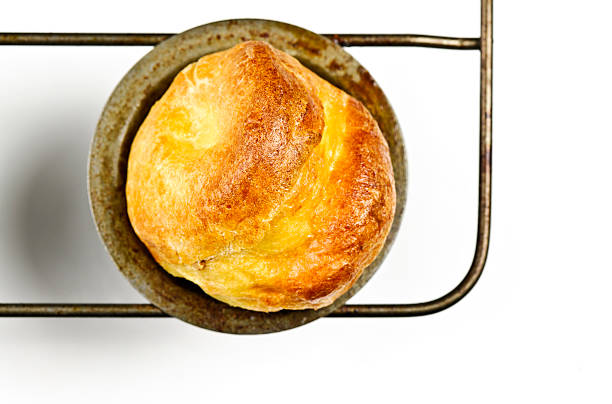
Benefits of Using Popover Pans
Here are the benefits of using popover pans:
Uniform Baking
- Popover pans are designed to distribute heat evenly, ensuring that popovers bake uniformly with a crisp exterior and fluffy interior.
Distinctive Shape
- The deep, narrow cups of popover pans create the iconic popover shape, allowing the batter to rise and puff up during baking.
Versatility
- While primarily used for popovers, these pans can also be used to bake muffins, mini cakes, savory bread rolls, and other individual-sized baked goods.
Easy Release
- Many modern popover pans feature non-stick coatings, making it easy to release baked goods without sticking and simplifying the cleaning process.
Portion Control
- Popover pans come in various sizes, allowing for portion control and flexibility in serving sizes based on the number of cups in the pan.
Durability
- High-quality popover pans, especially those made from materials like cast iron or stainless steel, are durable and can withstand repeated use without warping or deteriorating.
Crisp Texture
- The design of popover pans promotes the development of a crispy crust on the exterior of popovers, enhancing their texture and flavor.
Presentation
- Popovers baked in popover pans have an attractive appearance, making them suitable for serving at special occasions or for impressing guests with beautifully shaped pastries.
Overall, popover pans offer several benefits that make them a valuable tool for baking delicious and visually appealing treats with consistent results.
Tips for Using Popover Pans Effectively
Here are some tips for using popover pans effectively:
Preheat the Pan
- Preheat your popover pan in the oven before adding the batter. This helps ensure that the batter starts cooking immediately upon contact, leading to better rising and a crisp exterior.
Grease the Cups
- Even if your popover pan has a non-stick coating, it’s a good idea to lightly grease the cups with butter or cooking spray. This helps prevent sticking and ensures easy release of the popovers after baking.
Use Room Temperature Ingredients
- For best results, use room temperature ingredients when making popover batter. This helps the batter achieve the right consistency and rise properly during baking.
Fill the Cups Correctly
- Fill each cup of the popover pan about two-thirds to three-quarters full with batter. Overfilling can cause the popovers to spill over the sides or not rise properly.
Do Not Peek
- Avoid opening the oven door while the popovers are baking. The sudden change in temperature can cause them to deflate. Use the oven light to check on their progress if needed.
Bake at the Right Temperature
- Follow the recipe instructions for baking temperature and time. Popovers typically bake at a high temperature (around 400-450°F or 200-230°C) initially to encourage rapid rising, then the temperature is lowered for continued baking until golden brown.
Rotate the Pan
- If your oven has hot spots, rotate the popover pan halfway through baking to ensure even cooking.
Cool Properly
- Once baked, remove the popovers from the pan immediately and transfer them to a wire rack to cool slightly. This helps prevent them from becoming soggy from trapped steam.
Serve Promptly
- Popovers are best enjoyed fresh out of the oven while still warm and crisp. Serve them promptly with butter, jam, or other toppings of your choice.
By following these tips, you can use your popover pan effectively to bake delicious and perfectly puffed popovers every time.
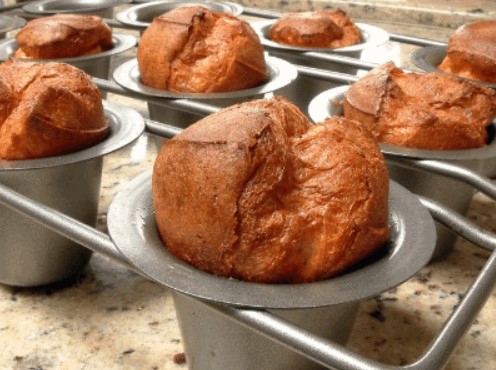
Popular Recipes and Dishes Made Using Popover Pans
Here are some popular recipes and dishes made using popover pans:
Popovers
- The classic recipe for popovers involves a simple batter of flour, eggs, milk, and salt. Popovers are baked in popover pans until they rise and form a hollow center, resulting in light and airy pastries that are perfect for breakfast or as a side dish.
Yorkshire Puddings
- Similar to popovers, Yorkshire puddings are a traditional British dish made from a batter similar to that of popovers. They are often served alongside roast beef and gravy, soaking up the flavorful juices from the meat.
Mini Cakes
- Popover pans can be used to bake individual-sized cakes, such as chocolate lava cakes, lemon cakes, or vanilla cakes. The deep cups of the pan help create a distinctive shape and ensure even baking.
Savory Muffins
- Use your popover pan to make savory muffins filled with ingredients like cheese, herbs, vegetables, or cooked meats. These muffins are perfect for brunches, picnics, or as a snack.
Frittatas or Quiches
- Popover pans can also be used to make individual-sized frittatas or quiches. Fill the cups with a mixture of eggs, cheese, vegetables, and proteins, then bake until set for a delicious and portable meal option.
Puff Pancakes
- Also known as Dutch babies or German pancakes, puff pancakes are made from a batter similar to that of popovers but are baked in popover pans until they puff up and become golden and crispy. They are often served with powdered sugar, fruit, or syrup.
Cheesy Bites
- Fill the popover pan cups with a mixture of cheese and herbs for cheesy bites that are perfect for appetizers or snacks. Bake until golden and bubbly for a deliciously indulgent treat.
These recipes showcase the versatility of popover pans and the wide range of delicious dishes that can be created using this baking vessel.
Replacements for Popover Pans
Here are some possible replacements for popover pans:
Muffin Pans
- Muffin pans can be a suitable alternative for baking popovers if you don’t have a popover pan. While the shape of the cups is different (muffin pans have wider and shallower cups), they can still produce similar results, especially if you fill the cups to the appropriate level to allow for rising.
Mini Cake Pans
- Mini cake pans with deep cups can also work well for baking popovers. These pans are designed to create individual-sized cakes, and their deep cups can help the batter rise and form the desired popover shape.
Cupcake Pans
- Cupcake pans are another option, although they typically have shallower cups compared to popover pans. You may need to adjust the filling level and baking time to accommodate the difference in cup depth.
Ramekins
- If you’re looking for a more makeshift option, ramekins can be used to bake individual-sized popovers. While they won’t have the same popover shape as traditional pans, they can still produce delicious and puffy pastries.
Ovenproof Mugs
- In a pinch, ovenproof mugs can be used to bake popovers. Make sure the mugs are heat-resistant and oven-safe. You may need to adjust the baking time and keep an eye on the popovers to prevent over-browning.
Cast Iron Skillets
- While not ideal for creating individual popovers, a cast iron skillet can be used to make a large popover that can be sliced and served. The skillet’s heat retention properties can help achieve a crispy exterior.
When using alternative pans, it’s essential to consider the size and shape of the cups, adjust the filling level and baking time accordingly, and monitor the baking process closely to achieve the desired results.
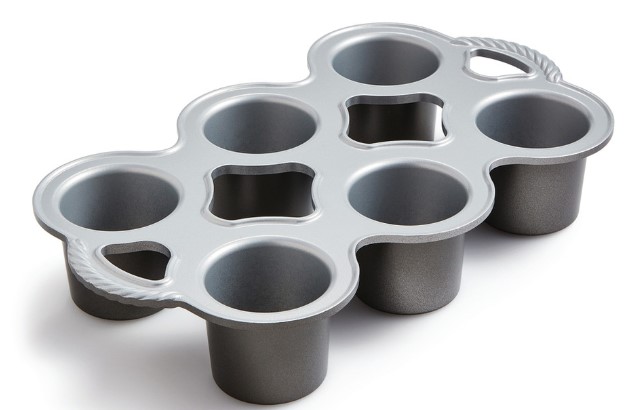
Frequently Asked Questions (FAQs) – What Is A Popover Pan
Q: What are popover pans used for?
A: Popover pans are specifically designed to create light, fluffy, and tall popover pastries. They have deep, narrow cups that help the batter rise and form the classic popover shape during baking.
Q: How does a popover pan differ from a muffin pan?
A: A popover pan differs from a muffin pan in its cup design. Popover pans have deeper and narrower cups compared to muffin pans, which allows the popover batter to rise upwards, creating the signature tall and airy popover shape.
Q: What are the benefits of using a dedicated popover pan?
A: Using a popover pan ensures that your popovers rise properly and achieve the desired height and texture. The pan’s design promotes even heat distribution, resulting in perfectly baked popovers with crispy exteriors and soft interiors.
Q: Can I use a muffin pan instead of a popover pan?
A: While you can use a muffin pan to make popovers, the results may not be as optimal as when using a dedicated popover pan. Muffin pans have wider and shallower cups, which may not allow the popovers to rise as high or develop the characteristic shape and texture.
Q: What materials are popover pans made of?
A: Popover pans are typically made of non-stick metal or heavy-duty aluminum. These materials ensure even baking and easy release of the popovers without sticking, making cleanup a breeze.
Q: Are popover pans easy to clean?
A: Yes, most popover pans are designed for easy cleaning. The non-stick coating or aluminum construction allows for effortless removal of baked-on batter, requiring only a simple rinse or light scrubbing.
Q: Can I use a popover pan for other baked goods?
A: While popover pans are specifically designed for popovers, they can also be used to make Yorkshire puddings, mini cakes, and other similar baked treats that benefit from the pan’s deep and narrow cup design.
Q: Do popover pans come in different sizes?
A: Yes, you can find popover pans in various sizes, from standard to mini versions. Choosing the right size depends on your recipe and the desired serving size of your popovers.
Q: What tips can enhance my popover baking experience?
A: To achieve the best results when using a popover pan, preheat the pan before adding the batter, fill each cup about two-thirds full, and avoid opening the oven door during baking to prevent deflating the popovers prematurely.
Q: Where can I buy a quality popover pan?
A: Quality popover pans can be found at kitchen supply stores, online retailers, and specialty baking shops. Look for reputable brands known for their durable construction and reliable performance for the best baking experience.
Conclusion
In conclusion, a popover pan is a versatile and essential tool for creating light, airy, and beautifully puffed pastries known as popovers.
Its unique design with deep, narrow cups promotes optimal rising and browning, resulting in perfectly crispy exteriors and tender interiors.
Whether you’re a seasoned baker or a novice in the kitchen, investing in a quality popover pan can elevate your baking game and impress your family and friends with delightful treats that are sure to please any palate.
Other Articles You May Also Like:
- What Is A Patty Pan (10 Surprising Facts To Know)
- What Is A Paella Pan (7 Surprising Facts To Know)
- What Is A Roasting Pan (9 Cool Facts To Know)
- What Is A Springform Pan (8 Cool Facts To Know)
- What Is A Loaf Pan (8 Cool Facts To Know)
- What Is A Muffin pan (9 Eye-Opening Things To know)
- What Is A Tart Pan (3 Surprising Facts)
- What Is A Tilt Skillet (4 Cool Facts To Know)